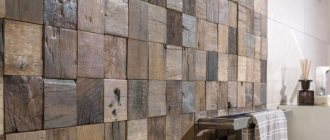2513
Nowadays, there is a huge selection of paving coverings on the market, which allows you to turn any design ideas into reality, sometimes even the most unusual ones. Thus, one of these unusual and original types is the paving slab “Footprints of a Giant”, which got its name because of its external resemblance to a human foot.
Original sidewalk covering
Advantages of paving slabs for a summer residence
The main advantages of country paving slabs are presented:
- Affordable price. Depending on the production technology, the average cost of such material can vary significantly. And thanks to the ability to make tiles yourself, it is possible to obtain a strong and durable material at minimal cost.
- Variety of designs. A significant number of options for the appearance of tiles allows you to create your own unique and original design of a country path. The tiles differ not only in size and shape, but also in texture and the ability to choose the optimal laying pattern.
- Low cost of coating maintenance during operation. The used street paving slabs can be partially dismantled or laid without the use of heavy or special equipment.
- Environmentally friendly materials used in the production of paving slabs. The constituent components do not contain toxic impurities or harmful dyes, so this building and finishing material is absolutely safe.
- Increased strength and reliability. Paving slabs made in accordance with established technology are capable of withstanding significant mechanical loads, are resistant to abrasion and temperature changes, and are characterized by excellent frost resistance.
The advantages of modern tiled flooring in the countryside also include ease of cleaning from dirt and ease of self-installation. Despite the impressive number of advantages, paving slabs also have some significant disadvantages, including slippery surfaces in winter and sagging of the finish if the laying technology is violated.
It is important to note that the average cost of paving slabs is higher than the price of asphalt pavement, but this construction and finishing material is more reliable and durable, as well as convenient to use.
Reasons for weed growth between tiles
Let's look at the reasons for the germination of weeds on a surface laid with paving slabs. It's simple: the gaps between the tiles are usually spilled with sand, and during operation the wind carries dust, soil and weed seeds into the seams between the tiles. Precipitation has a stimulating effect on seed growth - nature is doing its work - and the grass will not keep you waiting for its grand appearance.
Want to know how to solve problems with grass in paving slabs ? Read the article to the end and you will find the solution!
Types of paving slabs
All varieties of modern paving slabs differ in cost, are characterized by certain advantages and some disadvantages, and also differ in the production method:
- Vibro-cast paving slabs are the simplest and most affordable option, which is based on the method of vibration of the finished working solution. The advantages of this material include a special glossy front surface, color variety, minimal costs for the production process and components. The main disadvantages of vibration casting are insufficient strength, low resistance to low temperature conditions and lack of proper durability of the finished material.
- Vibration-pressed versions of paving slabs are characterized by increased strength even in the absence of heat treatment at the production stage. The undeniable advantages of vibration compaction are represented by a low level of susceptibility to mechanical damage, automation of the production process, and low susceptibility to temperature changes and low-temperature conditions. Disadvantages include a limited number of shades and shapes.
- Hyper-pressed paving slabs are practically not subject to deformation and various damage as a result of mechanical stress, and also have the advantage of long-term and trouble-free operation, which is due to their low susceptibility to low-temperature conditions and sudden temperature changes. The disadvantages are represented by the disadvantages that are characteristic of the vibrocompression process.
- Polymer sand paving slabs are an innovative option for street pavement and are characterized by the absence of cement. The main binders are polymer components and plasticizers, thanks to which the building and finishing material acquires wear resistance and strength, absolute water resistance, high frost resistance, durability and a rich color palette.
Despite the ease of installation, during the installation process it is necessary to take into account the significant linear expansion of the polymer sand material under high temperature conditions.
Landscape design
Paving slabs have now become widespread. Now they are laying out squares, pedestrian paths, private areas and summer cottages. Paving slabs easily fit into any landscape. Tiles have firmly taken a leading position as the No. 1 building material for landscape design.
And there is a reasonable explanation for this. Paving slabs have a lot of advantages that have firmly ensured their popular love. But is this material as perfect as it seems? In this article we will look at the main advantages of paving slabs for landscape design.
So, the first and most significant advantage of paving slabs is their environmental friendliness. Paving slabs are made only from concrete mixtures that are safe for humans and the environment. The tiles do not contain harmful impurities. In hot weather, it does not heat up and does not emit gases or toxic substances.
The next important property of paving slabs is their durability. Paving slabs are characterized by high strength and low abrasion, which ensures a long service life of the tiles for many years. The tile also has such quality as frost resistance, which allows it to be used in the harsh climate of Russia.
Paving slabs are easy to use. In case of any damage, the tiles can be easily removed and reinstalled after repair. This allows you to significantly save money on repairs. This can also be done if it is necessary to repair underground communications, when it is dismantled and replaced with a new, only the required section of the tile. At the same time, the integrity of the entire canvas is preserved.
Paving slabs do not require special care. So, during rain, all the moisture accumulates on the surface of the tile, and then the moisture seeps between the tile seams into the soil. Therefore, in winter there is no ice on the surface of the tiles, and in summer this helps to avoid the formation of puddles. The tiles are also easy to clean from any dirt.
Paving slabs allow you to realize any of your wildest landscape design ideas. You can create any compositions, patterns. This is facilitated by the wide variety of shapes, textures and colors of tiles; various sizes and thickness of tiles. At the same time, over time the tiles do not lose their rich colors.
The disadvantages include the cost of tiles, which, compared to asphalt, is slightly higher. But at the same time, if all installation and maintenance requirements are met, paving slabs turn out to be much more durable and reliable than asphalt pavement.
Therefore, having considered all the advantages and disadvantages of paving slabs, you can understand why this paving material is so in demand in the market of building materials for landscape design.
Features and design options
For the purpose of paving the local area, traditional rectangular tiles are most often used. Despite the simplicity of the form, the use of elements of different colors allows you to create different combinations and unusual patterns. A path made of figured tiles looks more original, but is more difficult to install.
The most popular, easy to implement and common schemes for laying country side paving slabs:
- “herringbone” - laid out with alternating elements;
- “braiding” - performed by alternating longitudinal and transverse elements;
- “chaos” - an arbitrary pattern is laid out from elements of different colors and sizes;
- “Chess” - laid out with two-color square tiles in a traditional checkerboard pattern.
Finished tiles in the country house
Patterned masonry
Particularly popular is the laying of paving slabs using a special circular template, which allows you to create a stylish and effective tile pattern.
The combination of tiles and lawn looks especially interesting. Such a beautiful and very harmonious combination of irregularly shaped paving slabs and tile joints looks impressive against the backdrop of green lawn grass.
Prices for tiles and their installation
The price aspect of paving stones The Old Town is quite affordable. Depending on the manufacturer and the popularity of the color scheme, the price per square meter may be as follows:
- Old city brick, diamond, clover, manufacturer Odessa, Ukraine. Price 1 sq. meters 3.5 US dollars.
- Assortment of paving stones in yellow shades, produced in Kharkov, Ukraine. Cost of 1 sq. meters 4.9 – 5.2 US dollars.
The cost of installation usually fluctuates somewhat depending on the category of the company performing the work and other factors. Typically the base cost is $2.1 - $2.5 per square meter of tile. This includes the execution of all work, from the zero cycle to commissioning.
More details about the options for laying paving stones are described here.
Preparing the base
The quality characteristics of the future masonry, as well as the durability of the finished tile covering, directly depend on the correct preparation of the base. Three methods of arranging the base are practiced, which are presented:
- sand base with fixation of the coating on top of the compacted cushion without the use of additional building materials;
- sand-cement base, based on the use of a dry mixture of cement and sand;
- a concrete base that allows you to lay tiles using special adhesive solutions.
Cement base
The basic requirements for preparing the base for tile covering are as follows:
- the creation of drainage drainage helps prevent the erosion of tiled street surfaces;
- arrangement of waterproofing, represented by a special substrate, prevents the flow of water from the ground;
- the drainage system includes a sufficient slope of the surface and the arrangement of drainage grooves;
- an optimally leveled surface helps to accurately fit all elements of street paving stones.
Burying the base into the ground provides the required surface height for laying paving.
Paving slab installation diagram
In order for the completed paving street covering to be characterized by durability and reliability, as well as in order to increase the stability of individual layers and prevent the formation of various deformations, the choice of the type of base must be approached very carefully.
Self-paving paths with paving slabs is one of the best options for arranging pavement in the local area. The installation technology is described in the article.
Types of paving slabs, as well as the pros and cons of each variety are described here.
Laying paving stones is a fairly simple task. Read on for details on how to do the work correctly.
Experts recommend for controlling grass between paving slabs
| Name | Purpose: | Manufacturer |
| GeotextileTYPAR type SF20 with a density of 200 g/m2 | Separating layer for the substrate, protection against germination of roots and weeds. | Taypar |
| Geotextile Avantex with a density of 100 g/m2 | As a separating and reinforcing layer between crushed stone and sand in the substrate when paving with paving slabs. | Avantex |
| Geotextile Geotex with a density of 150 g/m2 | Separating layer for the substrate, protection against root germination. | Sibur |
| Geotextile Kanvalan with a density of 150 g/m2 | As a separating and reinforcing layer between crushed stone and sand in the substrate when paving with paving slabs. . | Sibur |
| Dupont Geoproma | Separating layer for the substrate, protection against root germination. | Taypar |
| Geotextile Georex | For separating sand and crushed stone in road bases and paving with paving stones as a mulching covering. | GEOREX |
Laying paving slabs at the dacha
After the basic consumables, represented by stone or plastic curbs, cement, medium-fraction crushed stone, sand and geotextiles, have been purchased, and the base has been equipped, you can begin the direct laying of the coating:
- marking the area for installation;
- cleaning the area for installation;
- digging a trench according to the markings;
- backfilling the leveling sand layer;
- geotextile layer flooring;
- arrangement of drainage;
- installation of enclosing curb elements;
- arrangement of the supporting base;
- treatment of tile elements with a hydrophobic composition.
Do you want to get unique paving slabs? Then make it yourself. Do-it-yourself paving slabs - instructions for making and painting.
We will tell you further how to choose the right machine for paving slabs and how to make tiles using it.
The installation process itself may vary depending on the chosen technology and type of base.
If the base is a concrete surface, then the tile elements are fixed using traditional cement mortar. The tiles are laid on a leveled sand-cement base, followed by filling the joints with a special compound.
What to do if the tiles were laid before the widespread introduction of geotextile materials.
Experts offer several solutions for effective weed control, from which it is easy to choose the best option.
We immediately exclude from our attention the burning of weeds with a blowtorch or gas torch. The result will be short-term, and the tile covering itself may be damaged.
Damage or even discoloration of the surface of paving slabs can negatively affect the perception of the entire surface as a whole. Concentrated solutions of salt, acids and other chemically aggressive compounds are also not recommended. In any case, the grass roots, protected from damage, will restore the original “lawn” in a few days.
- From the old time-tested methods of combating inter-tile weeds, we can offer a simple recipe for a working solution. To prepare it, 4 kg of quicklime and 0.5 liters of sulfuric acid should be dissolved in 50 liters of water. After prolonged boiling and cooling, the solution is used to fill the gaps between the tiles.
- Another option is a solution of laundry soap. A high concentration of alkali stops seed germination and blocks the growth of grass whose roots are located under the tiles. The durability of the treatment is increased by soaking the seams treated with a soap solution and diluted with water in a 1:1 ratio with food vinegar.
As practice shows, this treatment allows you to get rid of weeds within 4-5 years. This treatment does not cause any harm to artificial tiles and natural granite paving stones.











